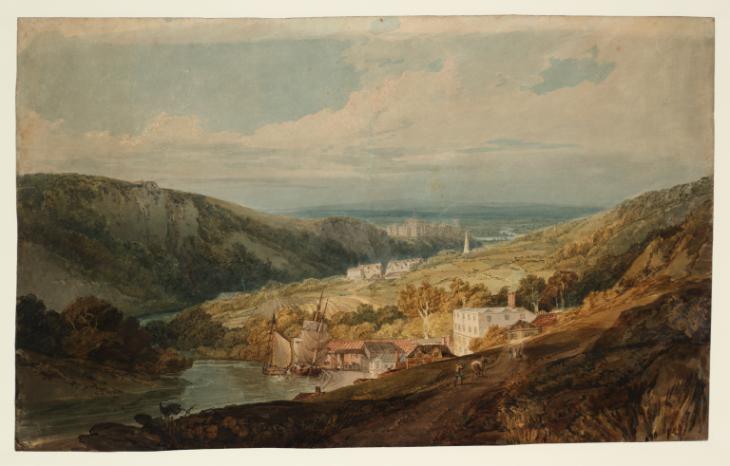Joseph Mallord William Turner Imaginary Landscape with Windsor Castle on a Cliff and a Distant Plain 1794-5
Joseph Mallord William Turner,
Imaginary Landscape with Windsor Castle on a Cliff and a Distant Plain
1794-5
Joseph Mallord William Turner 1775–1851
Imaginary Landscape with Windsor Castle on a Cliff and a Distant Plain c.1798
D00879
Turner Bequest XXXIII H
Turner Bequest XXXIII H
Pencil and watercolour on white wove paper, 457 x 736 mm
Blind-stamped with Turner Bequest monogram bottom right
Stamped in black ‘XXXIII H’ bottom right
Blind-stamped with Turner Bequest monogram bottom right
Stamped in black ‘XXXIII H’ bottom right
Accepted by the nation as part of the Turner Bequest 1856
Exhibition history
1975
Turner in the British Museum: Drawings and Watercolours, Department of Prints and Drawings, British Museum, London, May 1975–February 1976 (16, reproduced in colour).
References
1909
A.J. Finberg, A Complete Inventory of the Drawings of the Turner Bequest, London 1909, vol.I, p.66, XXXIII H, as ‘A View of Windsor Castle.’ c.1796–7.
1975
Andrew Wilton, Turner in the British Museum: Drawings and Watercolours, exhibition catalogue, Department of Prints and Drawings, British Museum, London 1975, p.34 no.16, reproduced in colour, pp.44–5.
2012
Eric Shanes, ‘Britain at Peace and War: J.M.W. Turner’s Four “State of the Nation” Surveys, 1793–1836’, in Windows on that World: Essays on British Art Presented to Brian Allen, London 2012, pp.212–17, 228–30, figs.109 (colour), 110 (colour detail), 113 (colour detail).
This most unusual watercolour is worked up to the point at which Turner would have considered it suitable for exhibition. It seems unlikely that it was executed on commission as its subject matter is clearly not topographical, though incorporating topographical elements: it seems to be a jeu d’esprit, inspired by Turner’s experience of South Wales and the Avon Gorge and presumably prompted by a recent visit to those places – his Welsh tour of 1798.
The foreground buildings are reminiscent of those at the Bristol Hot Wells; compare the Back View of the Hot Wells that he worked on in the early 1790s (Tate D00389; Turner Bequest XXIII O), while the church spire appearing over the hill is similar to that in Tate D01902 (Turner Bequest XLIV Z), which possibly represents Crickhowell. There are also echoes of the scenes of shipping in the Avon Gorge that he noted in his Cyfarthfa sketchbook in 1798 (see Tate D01663; Turner Bequest XLI 30). However, the distant plain is in fact too wide to be any of the river valleys of South Wales, and the large castle is evidently based on Windsor, though it may incorporate elements of Chepstow and Cilgerran, which Turner drew in the Hereford Court sketchbook (Tate D01261, D01342, D01279, D01280; Turner Bequest XXXVIII 11a, 88, 28, 28a) and the Dynevor Castle sketchbook (D01491–D01492; Turner Bequest XL 17a–18). Another fantasy composition dating from about this time is the Capriccio with the Dome of St Peter’s, Rome, Seen through a ruined Triumphal Arch (Tate D36667; Turner Bequest CCCLXXX 18), which is however a more comprehensible pastiche of an Italian tourist’s veduta in gouache, the typical medium of the souvenir views that Turner imitates there.
Eric Shanes re-dates the drawing to 1793, which is out of the question for technical and stylistic reasons:1 but this is clearly a work of the later 1790s, quite distinct from drawings of the early part of the decade. His proposal that the Avon Gorge was more evidently in the artist’s mind in 17932 than in 1798 is hard to prove in light of the fact that Turner had known the Gorge since his boyhood and returned there in 1798. Indeed the fact that he had begun his 1798 tour of Wales in Bristol (see the Introduction to the Hereford Court sketchbook; Tate; Turner Bequest XXXVIII) argues for a dating to that year rather than any earlier.
Shanes also renames the drawing ‘England at Peace’,3 reinterpreting the landscape to suit this idea, and arguing that Windsor Castle is symbolic in this context of a unified and happy kingdom. He relates the theme to a succession of works produced over the ensuing four decades of Turner’s life,4 linking it with the oil painting Ploughing up Turnips, near Slough (‘Windsor’) of 1809 (Tate N00486)5 and various views from Richmond Hill, notably England: Richmond Hill of 1819, which invokes the Prince Regent (Tate N00502).6 It is true that Turner was throughout his life concerned, like many of his contemporaries, with the spirit of England, especially during the Napoleonic Wars, and Shanes’s attempt to impose a conceptual meaning on the work is not necessarily irrelevant; but his larger thesis surely offers an implausibly broad overview of Turner’s long-term intentions. It also ignores the fact that all the other subjects in his proposed sequence are identifiable topographical views, while this is clearly a capriccio. In the context, it is worth noting Turner’s development of the themes of ‘Peace’ and ‘War’ in two Welsh historical subjects undertaken shortly after this; see Tate D04164 and D04168 (Turner Bequest LXX M, Q).
Technical notes:
The sheet has been folded vertically, down the centre.
Verso:
Blank; inscribed by a later hand in pencil ‘No 11B’, and illegibly; stamped in brown ink with Turner Bequest monogram.
Andrew Wilton
March 2013
How to cite
Andrew Wilton, ‘Imaginary Landscape with Windsor Castle on a Cliff and a Distant Plain c.1798 by Joseph Mallord William Turner’, catalogue entry, March 2013, in David Blayney Brown (ed.), J.M.W. Turner: Sketchbooks, Drawings and Watercolours, Tate Research Publication, April 2015, https://www

